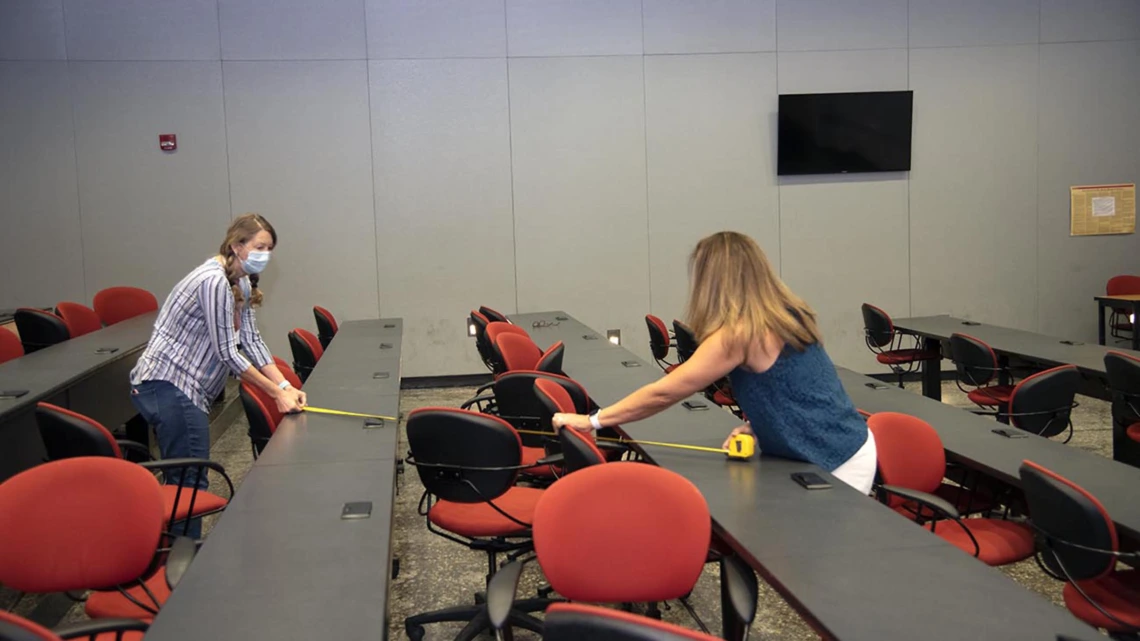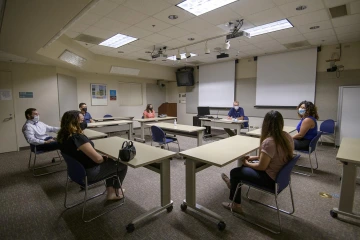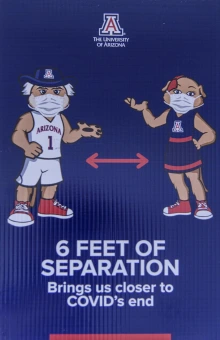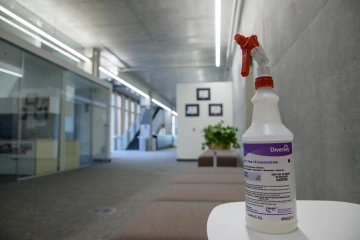What You Need to Know as You Return to Campus
Classes and work are resuming, but many things have changed to make campus life as safe as possible.

When the University of Arizona’s regular fall semester begins Aug. 24, those who return to campus will find it won’t be the same as it was in March, before almost all in-person activities ceased to help reduce the spread of COVID-19.
College of Medicine – Tucson students already have returned to some in-person activities, while students, staff and faculty in the College of Medicine – Phoenix won’t return until at least late September. In the other UArizona Health Sciences colleges, faculty are offering courses starting Aug. 24 in a combination of learning modalities to suit individual student needs and preferences.

A six-foot separation requirement for all gatherings means conference rooms and classrooms now accommodate fewer people.
To reopen the university safely, the Campus Reentry Working Group has mobilized various teams to implement numerous changes, from new guidelines and policies to building operations and security procedures. At the Health Sciences campuses in Tucson and Phoenix, planning and facilities in conjunction with Risk Management have put in place safety measures to help keep faculty, students and staff as safe as possible.
Angie Souza, executive director for Health Sciences planning and facilities, is responsible for the buildings on the Health Sciences campus in Tucson. David Heineking, assistant vice president for planning and operations at the university, is responsible for all Phoenix campus operations. Their teams have been checking and adapting air filtration systems, and installing sanitization stations, plastic barriers, and signage on doors, windows, elevators and hallways.
The university’s decision to reopen heavily relies on a plan called Test, Trace, Treat: testing for active infections, and for antibodies that reveal who has previously been exposed to the virus; contact tracing to mitigate its potential spread; and treating those who have tested positive for a current infection with wrap-around supports for health and education. As part of the reentry process, all employees and students must complete a daily Wildcat Wellcheck before they are on campus to help monitor potential symptoms and control the spread of the virus.
Souza and Heineking shared additional insights about what to expect if you’re returning to campus soon.
What’s the biggest change people will see in classroom learning settings?
The biggest change is the requirement to practice six-foot distancing, which means you're going to have fewer people in your space. We’ve measured classrooms and marked safe distances or removed furniture to reflect this, and we're providing paper towels and sanitizer to wipe down an area before and after you use it. This is true in classrooms and study areas, where we have created sanitization stations stocked with a disinfectant called Oxivir, paper towels, and the rules of using the space. One of those new rules is you're not supposed to move the furniture because we’ve measured and moved it to ensure individuals will be at least six feet apart when using it.
If we start to see people aren’t complying, we’ll close study areas and common areas. The goal is getting everyone to take responsibility.
For more information about returning to classrooms, visit the University of Arizona’s COVID-19 response page addressing education.
What’s the biggest change people will see in offices and work settings?

Signage throughout Health Sciences buildings reminds people to follow the guidelines for public health.
First of all, the campus Reentry Working Group has determined that the most effective means of preventing the transmission of COVID-19 is to minimize in-person interactions by working from home.
If you need to come to the office, one of the changes you’ll note is that we’re all being asked to continue to use Zoom or phone calls to meet, as opposed to getting together in a room. If you really need to meet in person, you’re still going to have to stay six feet apart. In many cases, this means only three or four people can sit at a table in a large conference room.
You can hold meetings outside with social distancing. The university is also requiring masks in all spaces, unless you can close your office door. That means even those who work at cubicles spaced more than six feet apart will need to wear a mask.
For more information, visit the University of Arizona’s COVID-19 response page addressing workspaces.
How can someone safely bring together a large group if needed?
First, we’re asking everyone to seek approval from Risk Management for a large gathering before they request space from Health Sciences scheduling or through the ASTRA or Pharmacy scheduling systems. Even with Risk Management approval, there are not a lot of spaces that accommodate a large group of people spread out with six feet of space between them.
Nearly all exterior doors to Health Sciences buildings require a CatCard to enter. Can you share the reason for this change?
It’s largely to ensure safety in all buildings while we have a lower number of people on the campuses.

Bottles of disinfectant spray and paper towels are placed throughout classrooms and common areas to enable regular cleaning.
CatCard-restricted access will help protect the safety of those who are on campus, at least until we have a better sense of how many people will be using the buildings regularly during the beginning of the semester. This is an example of one of the precautions we will evaluate as we get more information. Once we have a clear understanding of the activities in a building, we'll likely coordinate scheduled times for doors to be unlocked to coincide with some of those higher-traffic times, at the discretion of college leadership.
For now, everyone who enters needs to swipe their CatCard, and most buildings require a PIN. Each person must use their CatCard for entry, even if a few people enter at once. If you have trouble getting in to a building you believe you should have access to, reset your PIN at the top of the facilities management webpage in Tucson or send an email to pbc-access@arizona.edu in Phoenix or contact your college leadership office to troubleshoot.
Is the university providing masks to the campus community?
The university is providing two free masks for every student, staff and faculty member. The bookstores will distribute those on the Tucson and Phoenix Biomedical Center campuses, and a CatCard or PBC card will be required at pick-up.
The university has also shared additional guidance about face covering materials and fit, plus recommendations for use and cleaning.
What if I get sick? What if someone I’ve been in contact with gets sick?
Campus Health has developed steps to take if you’ve tested positive for COVID-19. Human Resources has developed steps if you are an employee who tests positive, or someone who supervises a person who tests positive. Additionally, the university has adopted the Covid Watch Arizona app for smartphones. When you use it, your phone’s anonymous Bluetooth signals can help in spreading the word quickly about potential exposures.
If you test positive, you can use the app to activate an anonymous notification only to others you came into close contact with, based on the private and secure Bluetooth signals. If you receive an alert after someone else tests positive, the alert will include information about what to do next.
Will there be food services available on Health Sciences campuses starting Aug. 24?
The food service options on the Health Sciences campuses are not guaranteed to be open. They will be evaluating how many people are on our campuses to decide whether to open. In Tucson, there is no longer general access to the Banner – University Medical Center Tucson cafeteria.
Should I report someone if I see they’re not following guidelines?
The university expects students, faculty and staff to follow its administrative directive to wear face coverings. As members of the Health Sciences community, it’s imperative that we each set the tone and lead by example during this public health crisis. In our experience, people understand the importance of these policies and I’ve observed people complying. We’ve often seen people walking alone outside without a mask, but when they see another person coming toward them, they put their mask on.
As we continue to make campus as safe as possible, university leadership has shared that students could face Code of Conduct violations, and could be removed from class for not wearing their face coverings. Employees could face disciplinary action for not complying with the directive.
We know the university is constantly evaluating the pandemic and local disease spread. What data or information are you looking at to inform whether these practices and protocols need to be adjusted?
The university is tracking state health data and sharing changes in procedures as warranted. We will always follow the university's guidelines related to increasing the number of people we have in our classrooms and offices, or reducing our use of common areas, for example.
What else is critical for people to know as campus begins to reopen?
We expect campus operations and policies to continue to evolve as the local public health situation changes, and as research and knowledge about the virus develop. The latest information is available on the university’s COVID-19 response and resources website.
The university will continue to provide updates via emails from leaders, including President Robert C. Robbins, MD, Senior Vice President for Academic Affairs and Provost Liesl Folks, PhD, MBA, Senior Vice President for Research and Innovation Elizabeth “Betsy” Cantwell, PhD, and Vice President and Chief Human Resources Officer Helena Rodriguez.
Photo Gallery: Implementing Safety Measures for Return to Campus

